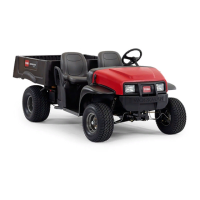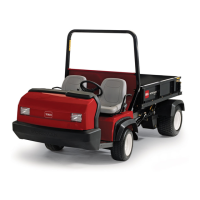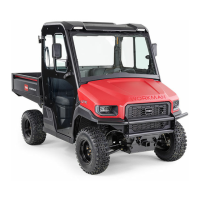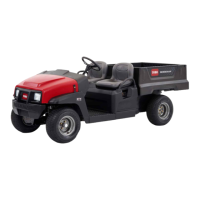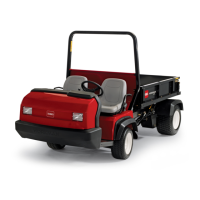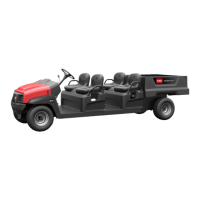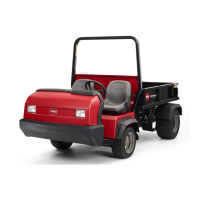During Operation
During Operation Safety
General Safety
• The owner/operator can prevent and is responsible
for accidents that may cause personal injury or
property damage.
• Passengers should sit in the designated seating
positions only . Do not carry passengers in the
cargo bed. Keep bystanders and children out of
the operating area.
• W ear appropriate clothing, including eye
protection; long pants; substantial, slip-resistant
footwear; and hearing protection. T ie back long
hair and do not wear loose clothing or loose
jewelry .
• Use your full attention while operating the
machine. Do not engage in any activity that
causes distractions; otherwise, injury or property
damage may occur .
• Do not operate the machine while ill, tired, or
under the inuence of alcohol or drugs.
• Operate the machine outdoors or in a
well-ventilated area only .
• Do not exceed the maximum gross vehicle weight
(GVW) of the machine.
• Use extra caution when operating, braking, or
turning the machine with a heavy load in the cargo
bed.
• Carrying oversized loads in the cargo bed reduces
the stability of the machine. Do not exceed the
carrying capacity of the bed.
• Carrying material that cannot be bound to the
machine adversely af fects the steering, braking,
and stability of the machine. When you carry
material that cannot be bound to the machine, use
caution when steering or braking.
• Carry a reduced load and reduce the ground
speed of the machine when operating on rough,
uneven terrain, and near curbs, holes, and other
sudden changes in terrain. Loads may shift,
causing the machine to become unstable.
• Before you start the machine, ensure that the
transmission is in neutral, the parking brake is
engaged, and you are in the operating position.
• Y ou and your passengers should remain seated
whenever the machine is moving. Keep your
hands on the steering wheel; your passengers
should use the handholds provided. Keep arms
and legs within the machine body at all times.
• Operate the machine only in good visibility .
W atch for holes, ruts, bumps, rocks, or other
hidden objects. Uneven terrain could overturn the
machine. T all grass can hide obstacles. Use care
when approaching blind corners, shrubs, trees, or
other objects that may obscure your vision.
• Do not drive the machine near drop-of fs, ditches,
or embankments. The machine could suddenly
roll over if a wheel goes over the edge or if the
edge gives way .
• Always watch out for and avoid low overhangs
such as tree limbs, door jambs, overhead
walkways, etc.
• Look behind and down before reversing the
machine to be sure of a clear path.
• If the machine ever vibrates abnormally , stop
and shut of f the machine immediately , wait for
all movement to stop, and inspect for damage.
Repair all damage to the machine before resuming
operation.
• It can take longer to stop the machine on wet
surfaces than on dry surfaces. T o dry out wet
brakes, drive slowly on a level surface while
putting light pressure on the brake pedal.
• Operating the machine at high speed and then
quickly stopping may cause the rear wheels to lock
up, which impairs your control of the machine.
• Do not touch the engine, transmission, muf er , or
muf er manifold while the engine is running, or
soon after you shut of f the engine, because these
areas may be hot enough to cause burns.
• Do not leave a running machine unattended.
• Before you leave the operating position, do the
following:
– Park the machine on a level surface.
– Shift the transmission to the N EUTRAL position.
– Engage the parking brake.
– Shut of f the machine and remove the key .
– W ait for all movement to stop.
• Do not operate the machine when there is the risk
of lightning.
• Use accessories and attachments approved by
The T oro® Company only .
Slope Safety
Note: A 2-post Rollover Protection System (ROPS)
is available for this machine as an accessory . Use a
ROPS if you will work next to drop-of fs, near water ,
in rough terrain, or on a slope, which could result in
a rollover . Contact an authorized T oro distributor for
more information.
Slopes are a major factor related to loss-of-control
and tip-over accidents, which can result in severe
injury or death.
19

